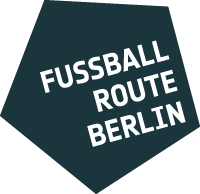2:7Jahn-Sportpark
Cantianstraße
Club football has been played here in the Jahn-Sportpark longer than anywhere else in Germany.
Since the middle of the 19th century, the parade grounds in the Schönhauser Allee have been used not only by the military, but has also been the site for public meetings and recreational activities. Already as early as the 1880s Berlin football pioneers used the site by the “Einsame Pappel” (“lonely poplar”) for their games, and it developed into the most important venue for matches in the city, second only to the Tempelhofer Feld. On this field, on Easter Monday 1892, the Dresdner FC played first against the all-star team of the Deutsche Fußball- und Cricket-Bund (German football and cricket association) and then against the English Football Club, and that was the first time in Germany that ropes were used to separate the spectators from the playing field. That is why despite the huge crowds a regular match could be held; indeed, the organizers could even collect the admission fee from the spectators. Around the turn of the century, many clubs from the northern and eastern districts of the growing metropolis relocated there, among them BFC Hertha, which had been established in 1892. Organized club football matches have been held here in today’s Friedrich-Ludwig-Jahn-Sportpark for longer than anywhere else in Germany. Even during the two world wars operations were interrupted only for a short time.
Additional topics on the information board
- Conversion into play and sports facilities
- The sports field during the Second World War
- Conversion to Jahn-Sportpark
- Youth work of the ASK Vorwärts
The stadium is the venue for many international matches.
The Berlin football club Dynamo, founded in 1966, is part of the Dynamo sports organization, which was supported and led by the GDR’s State Security Service and Ministry of the Interior. In the years between 1979 and 1988 the club won the GDR championship every year and thus qualified to compete for the European Champion Clubs‘ Cup. In 1982 and 1988 the team played in German-German matches against the Hamburger SV and Werder Bremen, and for the club functionaries these games smacked of class struggle. Despite a strong showing in the home games, BFC’s players were definitively defeated in the end. Above all the Stasi head Erich Mielke, who was also head of the sports association from 1953 until 1989, promoted and supported the football club. An enthusiastic fan, he did not shy away from intervening occasionally in the sporting events himself.
Additional topics on the information board
- Jürgen Nöldner
- Wins of the GDR’s national team
- Exodus of top athletes from the GDR
- GDR Cup competition
The BFV’s cup final in the Friedrich-Ludwig-Jahn-Sportpark is the high point of Berlin’s football season.
Modernized more than once, the Friedrich-Ludwig-Jahn-Sportpark has been used for cultural and sporting events, such as rock concerts, American football games and competitions in track and field athletics. Since 1995, the stadium has also been the venue of the Berlin Cup final. For the clubs organized in the Berliner Fußball-Verband (BFV, Berlin football association) the Berlin Cup final is the annual high point of the football season and also marks its end. After the unification of Germany and the reunification of Berlin football in 1990, teams from the West and the East are both entitled to compete for the Berlin Cup. The winner qualifies for the DFB Cup. In 2001, a “Turkish derby” is played because the SV Yeşilyurt Berlin and Türkiyemspor Berlin are playing against each other. The Berlin Cup final, which usually has not been getting much attention, garners an international audience thanks to being broadcast live on TV by the Turkish station TRT-int via satellite.
Additional topics on the information board
- Use of the Wall Park for sports
- Violence on the fringes of football
- SV Empor as neighbourhood club
- Respect Gaymes











